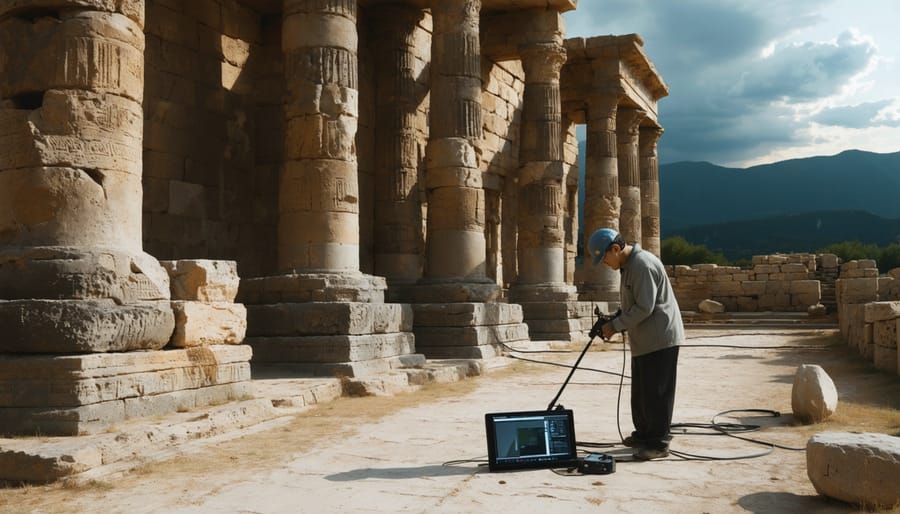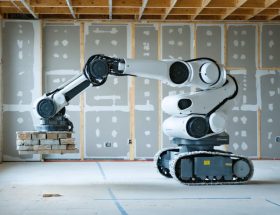Digital heritage stands at the intersection of cultural preservation and technological innovation, revolutionizing how we protect and share our collective history. Modern stone preservation techniques now incorporate advanced digital tools, from 3D laser scanning to photogrammetry, creating precise digital replicas of irreplaceable artifacts and monuments.
These digital preservation methods serve dual purposes: safeguarding our cultural heritage for future generations while making it accessible to global audiences through virtual platforms. Archaeological sites, historical buildings, and ancient artifacts are now documented with unprecedented accuracy, allowing conservators to track deterioration patterns and implement targeted conservation strategies.
The emergence of virtual museums, augmented reality experiences, and interactive digital archives has transformed how we experience and study cultural heritage. These technologies democratize access to historical knowledge, enabling researchers, educators, and enthusiasts worldwide to examine and analyze cultural artifacts without physical constraints or risks to the original objects.
This digital revolution in heritage preservation represents more than just technological advancement – it’s a fundamental shift in how we protect, study, and share our cultural legacy. By combining traditional conservation methods with cutting-edge digital tools, we’re creating a more resilient and accessible framework for preserving humanity’s most precious historical treasures.
Modern Digital Documentation Technologies
3D Laser Scanning and Photogrammetry
3D laser scanning and photogrammetry have revolutionized the way we document and preserve cultural heritage sites and artifacts. These technologies create highly accurate digital replicas that serve both preservation and educational purposes.
Laser scanning uses precision equipment to emit laser beams that measure millions of points on an object or structure’s surface, creating what’s known as a “point cloud.” This data captures every detail down to sub-millimeter accuracy, including surface textures, weathering patterns, and structural deformations. The resulting 3D models provide invaluable documentation for conservation efforts and serve as baseline records for monitoring changes over time.
Photogrammetry, on the other hand, uses multiple overlapping photographs taken from different angles to construct 3D models. This technique is particularly valuable for capturing color and texture information, making it ideal for documenting intricate architectural details, sculptures, and decorative elements. The process is more cost-effective than laser scanning and can be accomplished with high-quality digital cameras.
These technologies often work complementarily, with laser scanning providing precise geometric data while photogrammetry contributes detailed surface information. The combined approach results in comprehensive digital documentation that can be used for condition assessments, restoration planning, and virtual exhibitions. These digital records also ensure that even if physical damage occurs to heritage sites, their form and details are preserved for future generations.
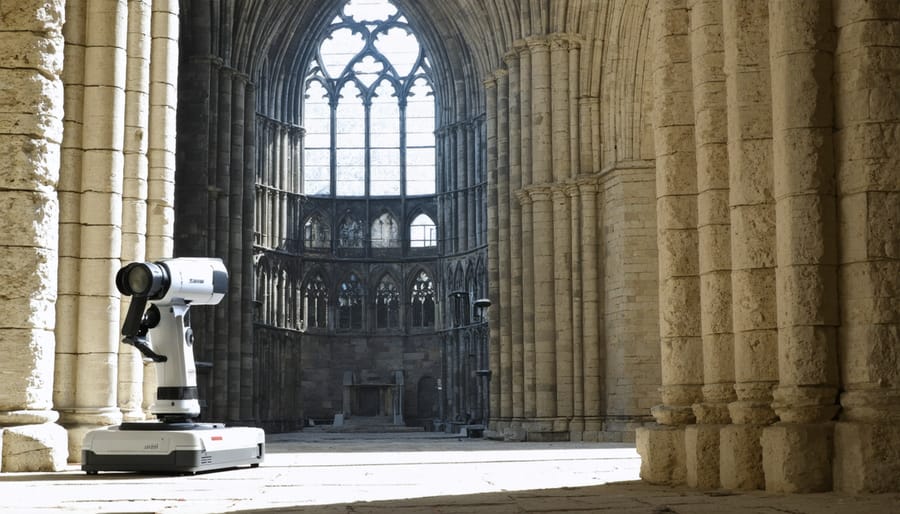
High-Resolution Photography and Imaging
High-resolution photography and advanced imaging techniques have revolutionized the documentation and preservation of stone heritage. Modern digital cameras equipped with high-megapixel sensors can capture intricate surface details, weathering patterns, and subtle color variations that might be invisible to the naked eye. These detailed images serve as crucial baseline documentation for monitoring degradation over time.
Photogrammetry has emerged as a particularly valuable tool, allowing conservators to create accurate 3D models from multiple overlapping photographs. This technique enables precise measurements and detailed surface mapping of stone artifacts and structures, providing a comprehensive record of their condition at specific points in time.
Advanced imaging technologies like multispectral and hyperspectral imaging reveal hidden features by capturing data across different wavelengths of light. These methods can detect previous repairs, identify various types of stone deterioration, and even reveal ancient inscriptions that have worn away over centuries.
Laser scanning technology complements these photographic methods by providing highly accurate geometric data. When combined with high-resolution photography, it creates detailed digital twins of stone monuments and artifacts that can be studied remotely, shared globally, and used for both conservation planning and public education.
The resulting digital archives serve as invaluable resources for future restoration work and provide a permanent record of our stone heritage for generations to come.
Digital Preservation Strategies
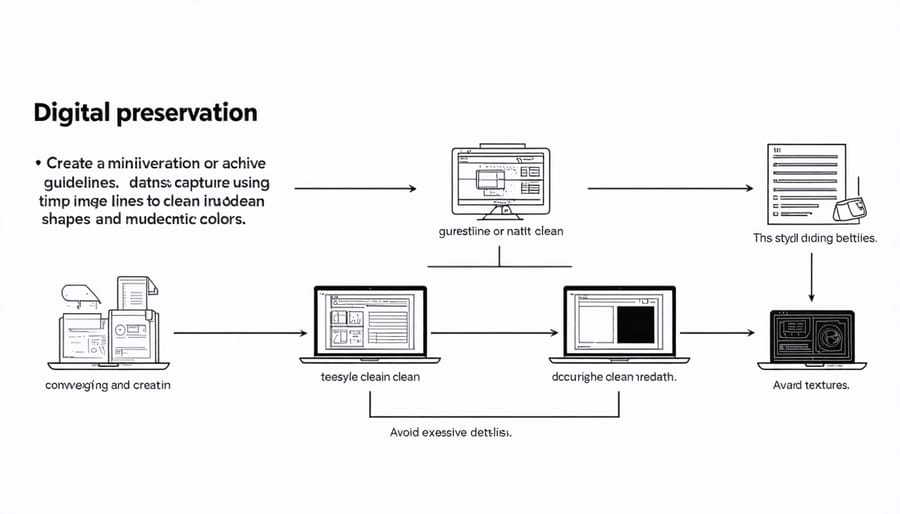
Data Storage and Format Standards
Proper data storage and format standards are crucial components of modern cultural heritage preservation. The most widely accepted file formats for digital documentation include high-resolution TIFF files for master images, PDF/A for documents, and XML for metadata. These formats ensure long-term accessibility and minimize the risk of data corruption or obsolescence.
For 3D data, industry standards typically include STL and OBJ files for geometric information, while point cloud data is commonly stored in PLY or LAS formats. These formats maintain the integrity of detailed surface measurements and spatial relationships crucial for stone preservation documentation.
Storage systems should implement redundant backups across multiple locations, preferably including both on-site and cloud-based solutions. The 3-2-1 backup rule is considered best practice: maintain three copies of data, store them on two different types of media, and keep one copy off-site.
Digital archives must also include comprehensive metadata documentation, describing not only the physical characteristics of heritage objects but also recording preservation histories, intervention methods, and environmental conditions. This information should follow standardized schemas such as Dublin Core or CIDOC CRM to ensure interoperability between different heritage institutions and future-proof access to the data.
Regular data verification and migration strategies are essential to prevent bit rot and ensure that stored information remains accessible as technology evolves.
Long-term Digital Archiving
Long-term digital archiving represents a critical component in preserving our digital heritage for future generations. The process involves implementing robust storage systems, regular data migration, and format conversion strategies to ensure digital artifacts remain accessible despite technological evolution.
Key preservation strategies include maintaining multiple copies across different storage media and geographic locations, implementing checksums to verify data integrity, and utilizing standardized file formats that promote long-term accessibility. Organizations often employ a combination of on-site servers, cloud storage solutions, and specialized digital preservation systems to create redundant safeguards against data loss.
Format obsolescence poses a significant challenge, requiring archivists to either maintain legacy systems or regularly convert files to current formats. The LOCKSS (Lots of Copies Keep Stuff Safe) principle has become a fundamental approach, emphasizing the importance of distributed preservation networks.
Metadata management plays a crucial role in long-term archiving, documenting not only the content itself but also its context, provenance, and technical specifications. This information ensures future users can understand and properly interpret preserved digital materials.
International standards like OAIS (Open Archival Information System) provide frameworks for building and maintaining digital archives. These standards help institutions develop sustainable preservation programs that can adapt to changing technological landscapes while maintaining the authenticity and accessibility of archived materials.
Regular assessment and updating of preservation strategies ensure that digital heritage remains viable and accessible for decades to come, protecting our cultural memory in the digital age.
Practical Applications and Case Studies
Historic Building Documentation
Historic building documentation has evolved significantly with the advent of digital technologies, transforming how we preserve architectural heritage for future generations. Notable examples include the digital documentation of Notre-Dame Cathedral in Paris, where laser scanning and photogrammetry created precise 3D models that proved invaluable during restoration planning after the 2019 fire.
The Historic England organization has pioneered comprehensive digital documentation projects across the United Kingdom, utilizing a combination of terrestrial laser scanning, drone photography, and Building Information Modeling (BIM) to create detailed records of heritage structures. Their work on Hampton Court Palace demonstrated how modern technology can capture intricate architectural details while providing valuable data for conservation efforts.
In Italy, the Venice Time Machine project exemplifies large-scale heritage documentation, combining historical records with advanced 3D modeling to create a four-dimensional model of the city’s architectural evolution. Similarly, the CyArk organization has documented over 200 heritage sites worldwide, including Angkor Wat in Cambodia and Mount Rushmore in the United States, creating detailed digital archives accessible to researchers and preservationists globally.
These projects not only preserve architectural information but also provide valuable resources for education, restoration, and disaster preparedness, ensuring that our cultural heritage remains accessible for study and appreciation by future generations.
Archaeological Site Preservation
Digital technologies have revolutionized archaeological site documentation, offering unprecedented precision in preserving ancient stone artifacts and structures. The adoption of 3D laser scanning and photogrammetry has transformed how archaeologists record and monitor heritage sites, creating detailed digital replicas that capture every surface detail with millimeter accuracy.
Notable examples include the digital preservation of Petra in Jordan, where LiDAR technology mapped intricate stone-carved facades, revealing previously undocumented architectural features. At Stonehenge, comprehensive 3D modeling has enabled conservators to track weathering patterns and structural changes over time, informing preservation strategies.
Digital documentation also proves invaluable for sites at risk. The Bamiyan Buddhas in Afghanistan, though physically destroyed, live on through detailed 3D scans taken before their destruction. These digital records now serve as crucial references for potential future restoration work.
Modern mapping techniques combine drone photography, ground-penetrating radar, and sophisticated software to create layered site models. These tools not only document visible remains but also reveal buried structures and architectural elements, providing archaeologists with comprehensive site data while minimizing physical intervention.
This digital approach ensures that even if sites face damage from natural disasters or human conflict, their historical and cultural significance remains preserved for future generations to study and appreciate.
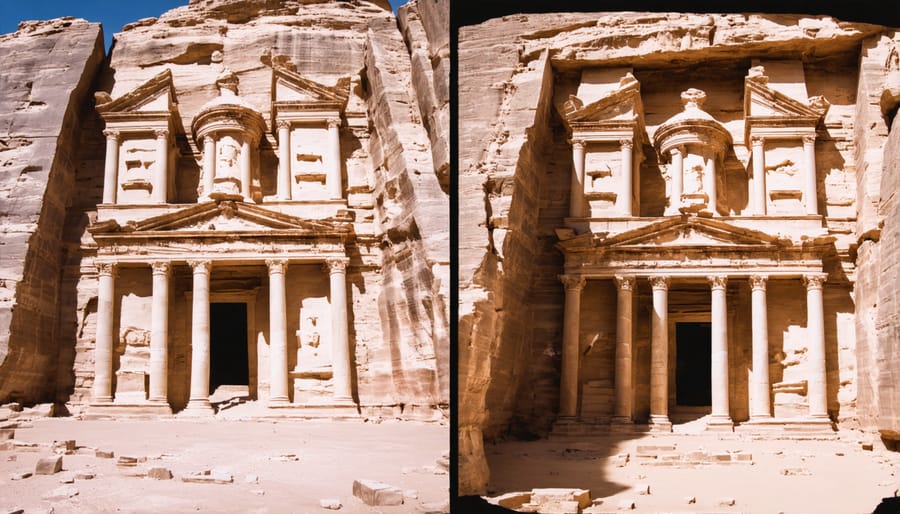
Future of Digital Stone Heritage
The future of digital stone heritage stands at an exciting crossroads where traditional preservation meets cutting-edge technology. As we continue to safeguard ancient stone monuments, emerging technologies are revolutionizing how we document, preserve, and share our cultural heritage.
Artificial intelligence and machine learning algorithms are becoming increasingly sophisticated in analyzing stone deterioration patterns, helping conservators predict and prevent damage before it becomes severe. These systems can process vast amounts of data from 3D scans and environmental sensors to create predictive models for stone conservation.
Virtual and augmented reality technologies are transforming how people experience historical stone artifacts. Visitors can now interact with detailed digital reconstructions of deteriorated monuments, seeing them as they appeared in their original state. This technology also enables remote access to cultural heritage sites, making them accessible to a global audience while reducing physical wear on the actual structures.
Blockchain technology is emerging as a powerful tool for authenticating and tracking digital heritage assets. This ensures the integrity of digital documentation and creates an unalterable record of conservation efforts and ownership history.
Looking ahead, we can expect to see:
– Advanced photogrammetry techniques that capture microscopic surface details
– Integration of IoT sensors for real-time monitoring of environmental conditions
– Development of sustainable digital preservation methods
– Enhanced 3D printing capabilities for creating exact replicas
– Improved data storage solutions for long-term digital preservation
These technological advances are not just about preservation; they’re creating new opportunities for education, research, and cultural exchange. As we move forward, the challenge will be balancing technological innovation with traditional conservation practices while ensuring these digital tools remain accessible to heritage institutions of all sizes.
The convergence of digital technologies with stone heritage conservation has revolutionized our ability to preserve and protect our cultural legacy for future generations. Through advanced documentation techniques, 3D modeling, and digital archiving, we can now capture, study, and monitor historic stone structures with unprecedented precision and detail. This digital transformation has not only enhanced our preservation capabilities but has also democratized access to cultural heritage, allowing people worldwide to experience and study these monuments virtually.
The impact of digital heritage extends beyond mere documentation. It provides conservators and researchers with powerful tools for preventive conservation, damage assessment, and restoration planning. By creating detailed digital records, we preserve not just the physical attributes of stone heritage but also maintain a comprehensive database of its history, condition, and transformation over time.
Looking ahead, the continued evolution of digital preservation technologies promises even more sophisticated solutions for heritage conservation. From artificial intelligence-assisted monitoring systems to virtual reality experiences, these innovations will further strengthen our ability to protect stone heritage while making it more accessible and engaging for future generations.
As we embrace these digital tools, it’s crucial to maintain a balance between technological advancement and traditional conservation practices, ensuring that our cultural heritage remains both physically and digitally preserved for centuries to come.

